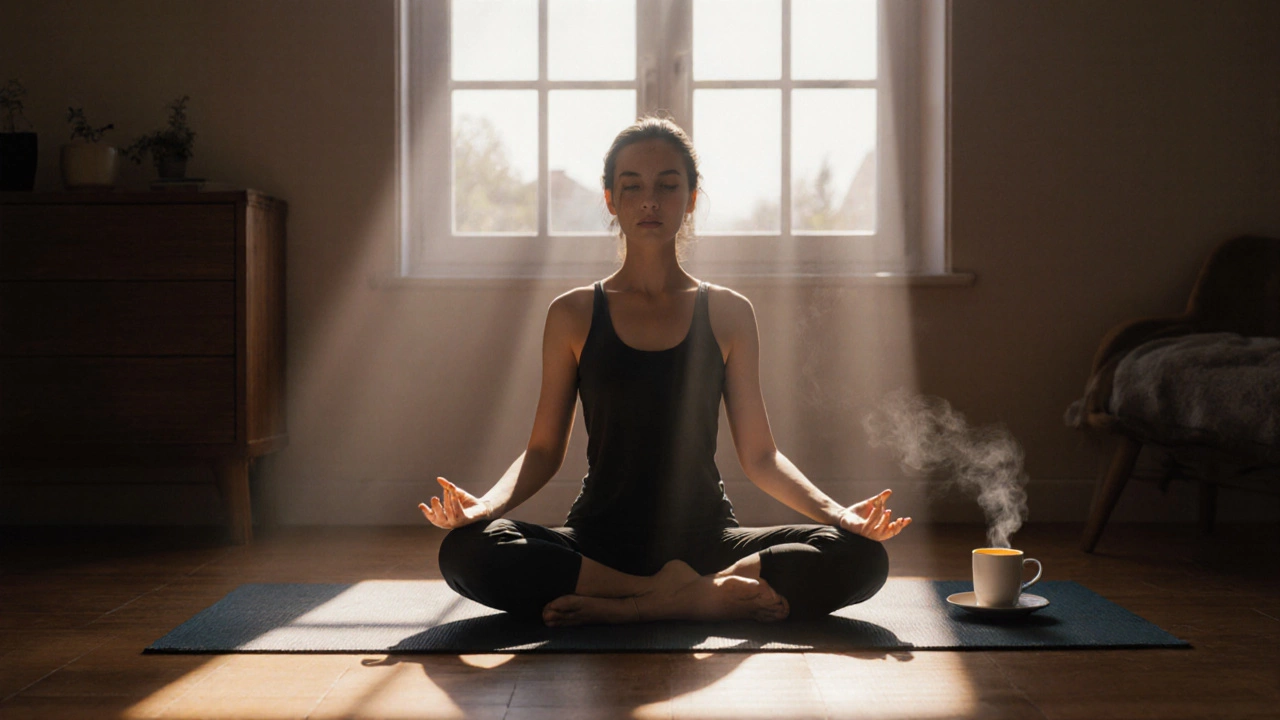Is It Better to Walk or Do Yoga? The Real Differences That Matter

Walking vs Yoga Goal Matcher
Which goal matters most to you today?
Let’s cut through the noise: no one needs another article saying walk and yoga are both good for you. Of course they are. But if you’re trying to decide which one to pick-maybe you’re short on time, or you’re tired of doing one and want to switch-then you need to know what each actually does to your body, mind, and daily life. This isn’t about which is ‘better.’ It’s about which one fits your goals right now.
Walking: The Quiet Powerhouse
Walking isn’t glamorous. You don’t post it on Instagram. You don’t need special gear. You just put on shoes and go. But here’s what walking does that few other activities can match: it lowers your risk of heart disease by up to 30% over five years, according to the American Heart Association. That’s not a guess. That’s data from tracking over 70,000 adults for a decade.
It’s also the most consistent way to burn calories without stressing your joints. A 160-pound person walking at 3.5 mph burns about 150 calories in 30 minutes. That’s not much compared to running, but it’s sustainable. You can do it every single day. You can do it in the rain, at dawn, after dinner. You can walk while talking to a friend, listening to a podcast, or watching the sunset. It’s the only exercise that doesn’t feel like exercise.
And it’s not just physical. A 2023 study in The Lancet Psychiatry found that people who walked 20 minutes a day, five days a week, reported lower levels of anxiety and depression than those who didn’t. Not because they were ‘meditating’-just because they moved outside, in natural light, without screens.
Yoga: More Than Stretching
Yoga gets called a workout. But if you’ve ever done a 60-minute session and felt like your nervous system got a reset, you know it’s something else. It’s not about how deep you can get into a pose. It’s about how still you can stay inside it.
Research from Harvard Medical School shows that regular yoga practice reduces cortisol-the stress hormone-by an average of 25% in just eight weeks. That’s more than what some medications achieve. And it’s not just calming your mind. Yoga improves balance, posture, and joint mobility. A 2024 review in the Journal of Orthopaedic & Sports Physical Therapy found that people with chronic lower back pain who did yoga twice a week saw 40% more improvement than those who only did stretching or physical therapy alone.
Yoga also builds body awareness. You start noticing how you hold tension-in your shoulders, your jaw, your hips. You learn to breathe through discomfort instead of avoiding it. That skill doesn’t stay on the mat. It shows up when you’re stuck in traffic, arguing with a coworker, or lying awake at 2 a.m.
But yoga has limits. It doesn’t raise your heart rate enough to count as cardio. Most styles won’t help you lose weight faster than walking unless you’re doing power yoga or vinyasa for 45+ minutes daily. And if you’re new to it, you might get discouraged trying to match someone else’s pose. That’s not yoga. That’s performance.
What You’re Actually Trying to Fix
Let’s get real. Why are you asking this question?
If you’re tired, stressed, and feel like your body is locked up-yoga will help more than walking. It will loosen your hips, quiet your mind, and give you a sense of control you didn’t know you were missing.
If you’re trying to lose weight, improve your heart health, or just get moving without thinking too hard-walking wins. You’ll burn more calories over time, stick with it longer, and actually enjoy it.
Here’s a simple way to decide:
- Choose walking if you want steady energy, better sleep, and a habit you can keep for life.
- Choose yoga if you want to reduce anxiety, fix tightness in your neck or back, or learn how to breathe when life gets heavy.
And if you’re still stuck? Do both. Not as a chore. As a rhythm.

How to Combine Them Without Overloading
You don’t have to choose one. Most people who stick with fitness long-term don’t. They layer activities based on how they feel that day.
Here’s what works for thousands of people:
- Monday, Wednesday, Friday: 30-minute walk after work. No headphones. Just look around.
- Tuesday, Thursday: 20-minute yoga session before bed. Focus on breathing, not poses.
- Saturday: Walk in a park, then do 10 minutes of yoga on a bench.
- Sunday: Rest. Or walk without a goal.
That’s it. No fancy gear. No apps. No pressure. You’re not training for a competition. You’re training to feel better in your own skin.
One person I talked to-a 58-year-old teacher-said she started walking 10 minutes a day because her knees hurt. After two months, she added a 15-minute yoga video on YouTube. Now, she walks every morning and does yoga every night. She says, “I don’t feel like I’m fixing my body. I feel like I’m finally listening to it.”
Common Mistakes People Make
People treat walking like a punishment. They count steps like a score. They feel guilty if they don’t hit 10,000. That’s not walking. That’s stress with shoes.
People treat yoga like a competition. They chase handstands. They compare their flexibility to someone online. That’s not yoga. That’s Instagram.
Both become useless when you turn them into tasks instead of habits. The goal isn’t to do more. It’s to feel more.
Walking isn’t about distance. It’s about presence.
Yoga isn’t about flexibility. It’s about resilience.

What Science Says About Long-Term Results
A 2024 study from the University of California tracked 1,200 adults over three years who either walked daily, did yoga three times a week, or did neither.
Results:
- Walkers: 22% lower risk of high blood pressure, 18% improvement in sleep quality, 12% increase in daily energy levels.
- Yoga practitioners: 31% reduction in chronic pain, 27% drop in perceived stress, 20% improvement in focus and memory.
- Non-exercisers: No significant changes in any category.
The takeaway? Both work. But they work in different ways.
Walking strengthens your body from the outside in. Yoga strengthens your mind from the inside out.
When to Switch or Add One
Here’s a quick guide to knowing when it’s time to shift:
- Switch from walking to yoga if you’re constantly stiff, anxious, or sleeping poorly-even if you walk every day.
- Switch from yoga to walking if you feel sluggish, your heart feels heavy, or you can’t lose weight despite consistent practice.
- Add yoga to walking if you’re feeling emotionally drained or mentally foggy.
- Add walking to yoga if you’re feeling stagnant, unmotivated, or emotionally numb.
There’s no wrong choice. Only choices that don’t match your needs right now.
Final Thought: It’s Not About Which Is Better
It’s about which one shows up for you when you need it most.
Some days, you need to move your body without thinking. Walk.
Some days, you need to stop moving and just breathe. Do yoga.
You don’t have to pick one. You just have to show up-however you can.
Can I lose weight by walking or doing yoga?
Walking is more effective for weight loss because it burns more calories over time. A 30-minute walk burns around 150 calories; most yoga styles burn 100-150 calories in the same time. But yoga helps with weight loss indirectly by reducing stress-related eating and improving sleep. For real results, combine walking with mindful eating-yoga alone won’t melt fat.
Is yoga better than walking for back pain?
Yes, for most people. Yoga improves mobility, strengthens core muscles, and teaches you how to move without straining your spine. A 2024 study found yoga reduced chronic lower back pain by 40% more than walking or stretching alone. Walking helps too-by improving circulation and reducing stiffness-but yoga targets the root causes of pain directly.
Do I need equipment for yoga or walking?
Walking needs nothing but comfortable shoes. Yoga needs a mat, but even a towel or carpet works. You don’t need blocks, straps, or fancy clothes. The only thing you need is space to move. Don’t let gear stop you.
Which is better for anxiety?
Yoga is more effective for anxiety because it directly trains your nervous system to calm down. Breathing exercises, slow movements, and mindfulness in yoga lower cortisol levels and reduce the fight-or-flight response. Walking helps too-especially outdoors-but yoga gives you tools to manage anxiety in the moment, not just after.
Can I do yoga every day?
Yes, and many people do. Gentle or restorative yoga daily is safe and beneficial. Avoid intense power yoga every day if you’re new-it can lead to overuse injuries. Listen to your body. Some days, 10 minutes of breathing on the floor is enough. That’s still yoga.
Is walking enough for fitness?
For most people, yes. Walking improves heart health, lowers blood pressure, reduces belly fat, and boosts mood. The CDC recommends 150 minutes of moderate activity per week-walking at a brisk pace easily hits that. You don’t need to run, lift, or do HIIT unless you have specific goals like building muscle or running a marathon.
If you’ve been stuck wondering whether to walk or do yoga, stop comparing. Start choosing based on how you feel today. Then do it again tomorrow. That’s how real change happens-not by picking the ‘best’ option, but by showing up consistently, in the way your body asks for.